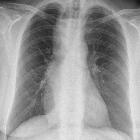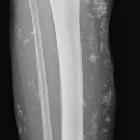scleroderma
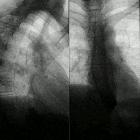

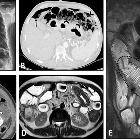








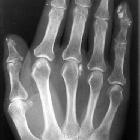








Scleroderma, also known as systemic sclerosis, is an autoimmune connective tissue disorder characterized by multisystem fibrosis and soft tissue calcification. As such, it affects many separate organ systems, which are discussed separately:
- musculoskeletal manifestations of scleroderma
- pulmonary manifestations of scleroderma
- cardiac manifestations of scleroderma
- gastrointestinal manifestations of scleroderma
- hepatobiliary manifestations of scleroderma
- renal manifestations of scleroderma
The remainder of this article is a general discussion of scleroderma.
Epidemiology
Although presentation in childhood is indeed recognized , scleroderma is considered a disease of middle age (30-50 years of age) . There is a strong female predilection (F:M 3:1), even more pronounced during reproductive years (F:M 10:1) .
Clinical presentation
Clinical manifestation depends on which systems are predominantly involved. It should be noted that the majority of patients 70-97% develop an arthropathy that mostly affects the fingers, wrists, and ankles . Esophageal involvement is common, occurring in approximately 80% of patients . Although 90% of patients have pulmonary involvement histologically, only a minority are symptomatic .
Pathology
The disease is characterized by widespread deposition of collagen and other extracellular matrix proteins. This is believed to occur as a result of an abnormal immune response. Small vessels are involved early in the disease, accounting for the involvement of organs with a dense capillary network. This results in perivascular fibrosis and gradual luminal stenosis .
Markers
Serological markers include:
- elevated erythrocyte sedimentation rate (ESR)
- rheumatoid factor (RF): positive in 30-40%
- antinuclear antibodies (ANA): 35-96%
- anti SCL-70: 30-70% (particularly in diffuse disease)
- anti-centromere antibodies: 20-40% (particularly in limited disease)
- antitopoisomerase I
Associations
- CREST syndrome
- other connective tissue disorders:
Radiographic features
These are best discussed under manifestations of individual systems. Please refer to respective subsections.
Treatment and prognosis
No cure for scleroderma exists. Treatment aims to reduce systemic involvement and target particular symptomatic organ systems. For targeted therapy, please refer to the articles that pertain to scleroderma and the particular body system.
Systemic medication aimed at reducing the deposition of fibrous tissue and at reducing inflammation has been tried with limited success .
Overall prognosis is variable, depending on the organ(s) involved and the severity. For patients with limited cutaneous involvement, 10-year survival is approximately 75%. However, patients with diffuse involvement have a 10-year survival closer to 55% .
Siehe auch:
- Dünndarmileus
- Sklerodermie Ösophagus
- Achalasie
- Glasrohr-Ösophagus
- Pseudoachalasie
- Dermatomyositis
- systemischer Lupus Erythematodes
- Akroosteolyse
- Wandstarre unterer Ösophagus
- Ösophagusstrikur
- CREST syndrome
- pulmonary manifestations of scleroderma
- gastrointestinale Manifestationen Sklerodermie
- Störungen der ösophagealen Peristaltik
- Sprue
- stack of coins
- hepatobiliary manifestations of scleroderma
- Stiff-skin-Syndrom
- muskuloskelettale Manifestationen bei Sklerodermie
- Morbus Hirschsprung beim Erwachsenen
- Graft-versus-Host-Reaktion kutan
- oesophageal cancer (adenocarcinoma)
- pseudo-obstruction
und weiter:
- verkalkte mediastinale Lymphknoten
- Hypomotile Achalasie
- Kardiomegalie
- gluteal injection site granuloma
- Interstitielle Lungenerkrankung
- Thymushyperplasie
- interstitial pneumonia
- nephrogenic systemic fibrosis
- mixed connective tissue disease
- radiologisches muskuloskelettales Curriculum
- Fibrodysplasia ossificans progressiva
- bilaterale axilläre Lymphadenopathie
- retikuläres Muster
- Osteolyse der distalen Klavikula
- conditions involving skin and bone
- Winiwater-Buerger-Krankheit
- Lepra
- Candida Ösophagitis
- Rheuma Differentialdiagnose
- differential diagnosis of intramuscular high STIR signal on MRI
- ACJ erosion
- Nageldystrophie
- pneumatosis intestinalis (mnemonic)
- Hypermotile Achalasie
- Muskelödem
- Werner-Syndrom
- Scleroderma (renal manifestations)
- Raynaud-Syndrom
- acro-osteolysis (mnemonic)
- Flynn-Aird-Syndrom
- distal clavicular erosion
- Wassermelonenmagen
- diffuse small bowel disease
- dystrophic soft-tissue calcification
- stack of coins bowel sign
- linear scleroderma
- eosinophilic fasciitis
- zirkumskripte Sklerodermie
- foamy oesophagus sign
- Huriez-Syndrom
- scleroderma with NSIP
- conditions with a lower lobe predominance (mnemonic)
- Pneumatosis intestinalis bei Sklerodermie
- Sjogren's syndrome in scleroderma
- Sjörgen Syndrom hand
- primär biliäre Cholangitis
- Merkspruch Weichteilverkalkungen
- bowel sacculation (mnemonic)
- kardiale Manifestationen bei Sklerodermie

 Assoziationen und Differentialdiagnosen zu Systemische Sklerodermie:
Assoziationen und Differentialdiagnosen zu Systemische Sklerodermie:
